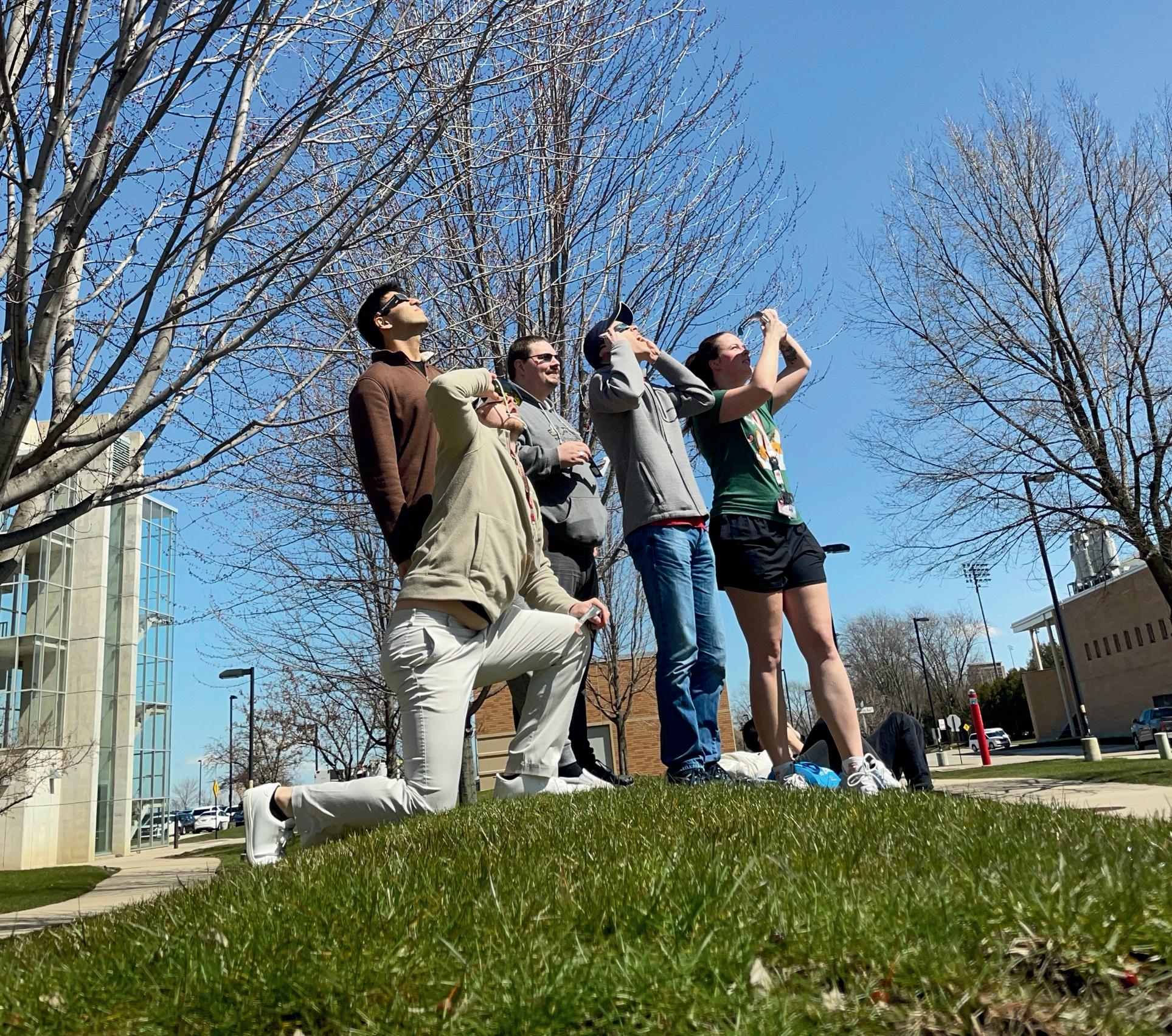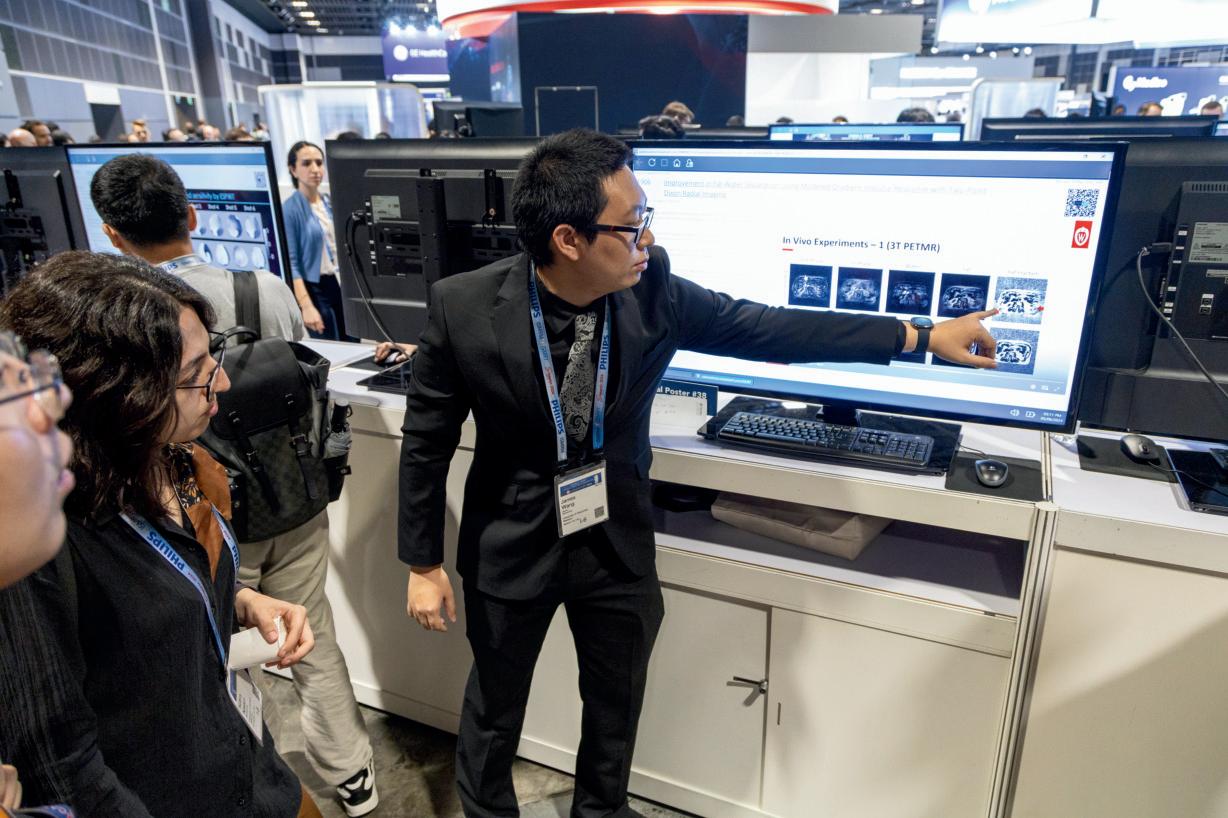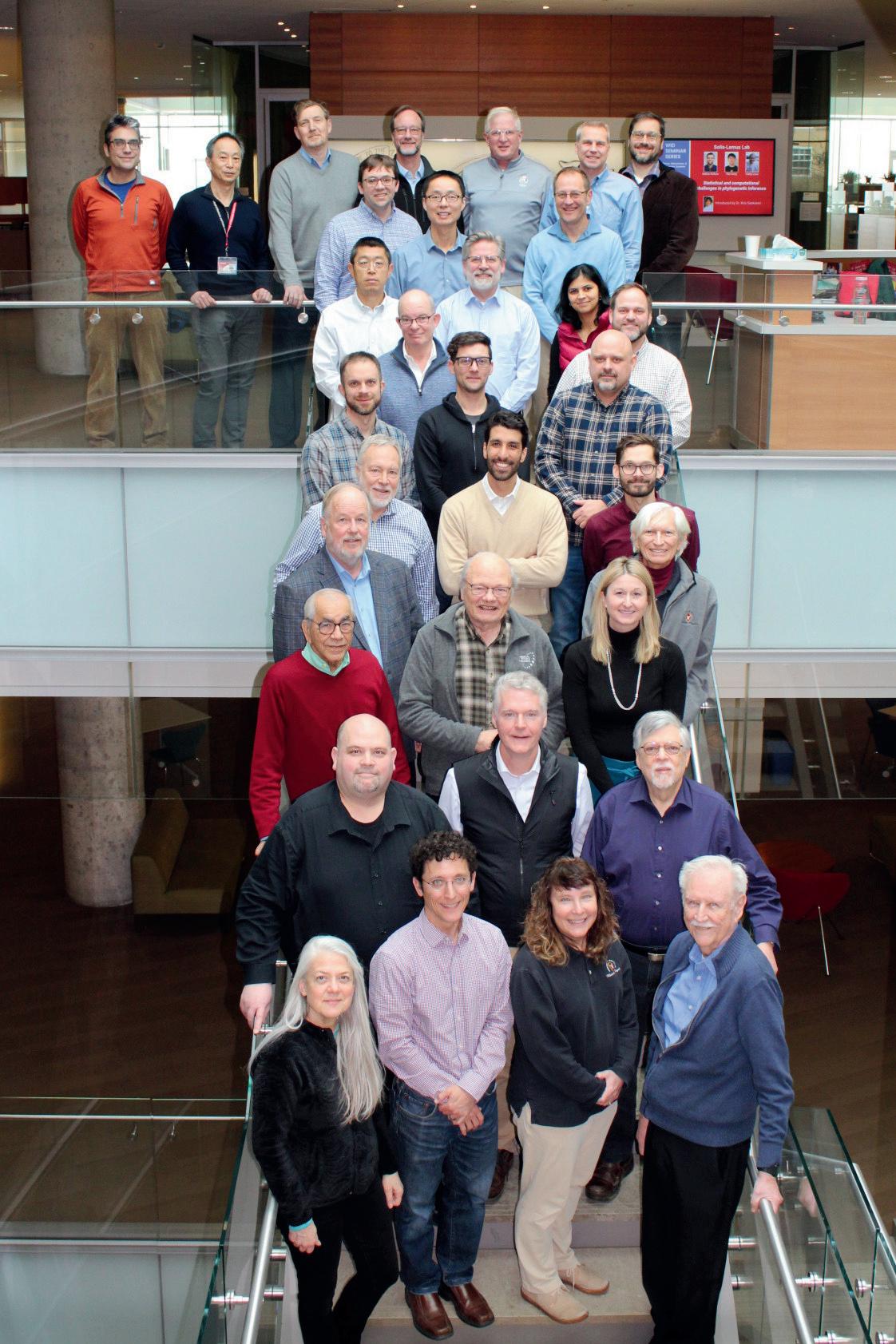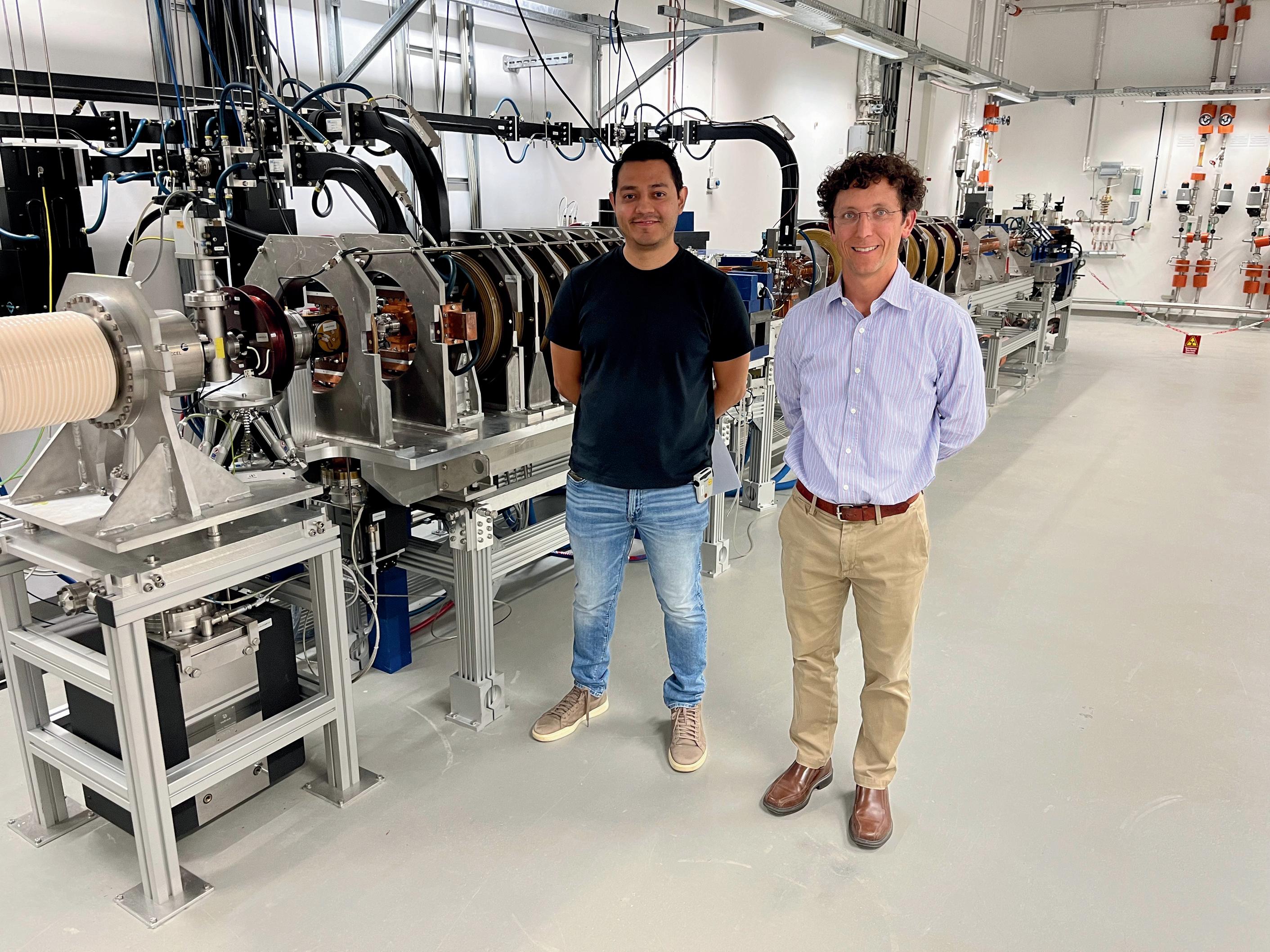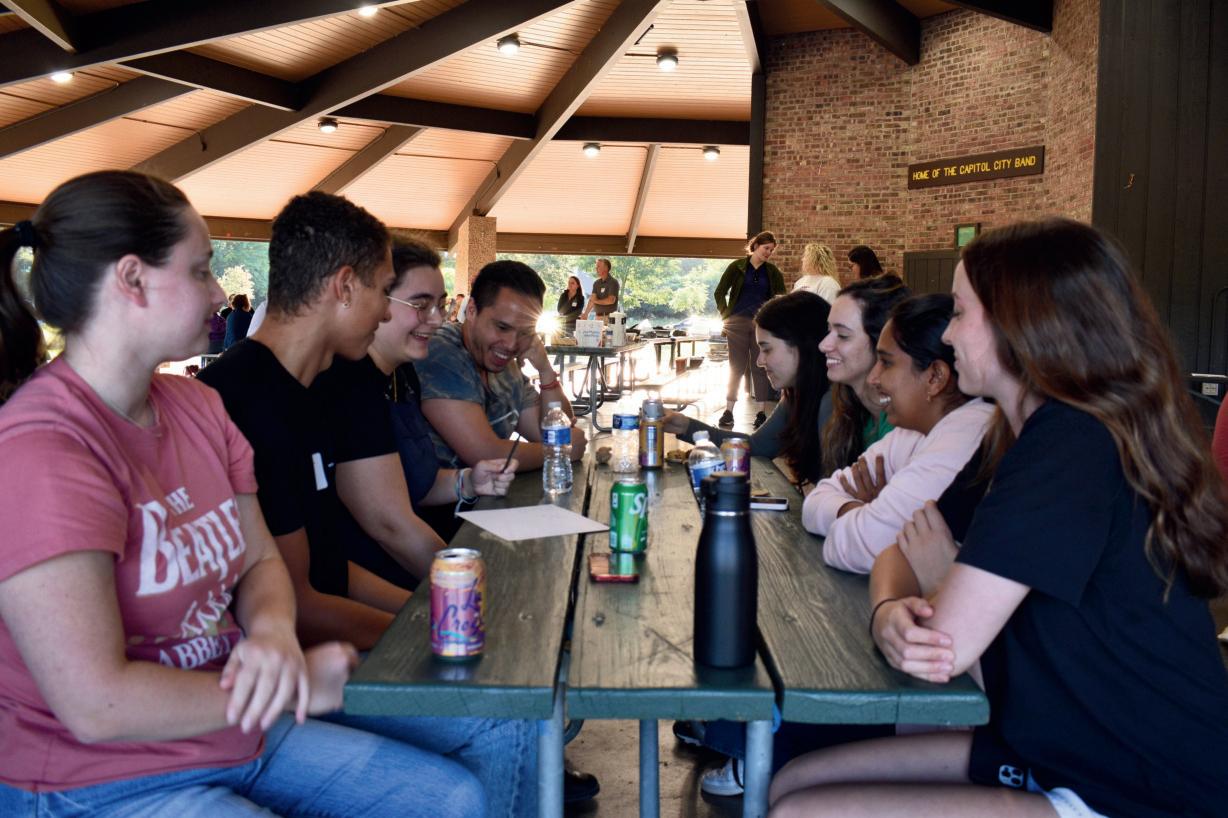THE MEDICAL PHYSICIST
NEWS FROM THE DEPARTMENT OF MEDICAL PHYSICS - SUMMER 2024




NEWS FROM THE DEPARTMENT OF MEDICAL PHYSICS - SUMMER 2024



Department
Department
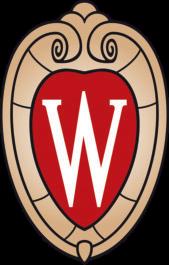
Professor Brian Pogue, PhD

To our Alumni & Former & Current Faculty, Students, Residents, & Staff:
This past year has been astounding in the run of successes for our department Our mission continues to be supporting people, their discoveries and inventions, and seeing that translation of this work shapes the field of device-based medicine The starting place for all this comes from our outstanding faculty, staff, and students, supplied with an unparalleled research infrastructure, that helps us preserve our position at the leading edge of research and development.
We support everyone by ‘leading the pack’ in researchinfrastructurethathelpspreserveour

position at the cutting edge of imaging and therapy systems. Our faculty also are adept at working with industry throughout their research and leveraging our position in the scientific world to gain access to unique technologies. The department’s research revenue continues to grow, withover $10 millioninannualgrantawards, which is our core line of funding for people and productivity.
This year we initiated one of the largest infrastructure decisions at the University of Wisconsin School of Medicine and Public Health, to financially support the building of a new cyclotron facility. Infrastructure such as this will inevitably boost our research capacity and educational potential for decades to come. This new cyclotron facility will be sited between WIMR I and II on the basement level, expanding our current radionuclide production activity. This effort was spearheaded by the ‘Cyclotron Gang’ faculty and scientists, led by Associate Professor Jonathan Engle. Construction is slated to begin by next year and project planning is well underway Radionuclide users across the country and here at UW–Madison will inevitably increase asthisincredibleresourceisrealized.
A brand new announcement on July 2 was the funding of the Wisconsin Biohealth Tech Hub project, whichbringsatotalof $49 millionfederal funding to our area from the U.S. Dept. of Commerce Economic Development Administration, with additional matching funds from the State of Wisconsin and institutional supports The direct impact of this award on our department will be through work with GE Healthcare in imaging systems and the Wisconsin Health Data Hub creation. The strength of medical physics in Wisconsin was a core part of theoriginofthisinitiative.
Later this summer, the department will host two concurrent events beginning with a Memorial Celebration for Paul M. DeLuca PhD, on Wednesday, August 21, 3-5 p.m. at the Pyle Center Allareinvited AnobituaryforDr DeLuca is available on page 15 of this newsletter In addition, the following two days we will host our Emerging Leaders of Academic Medical Physics symposiumandworkshops, wherewewillconnect emerging leaders in the field of medical physics witheightluminarykeynotespeakers, andprovide aforumtoreflectoncareersinacademicmedical physics and the future of our field. We look forward to seeing many of you there! A list of this year ’skeynotespeakerscanbefoundonpage 14.
This fall we will welcome 21 new students to our graduate program In addition, the department will host Cynthia McCollough, PhD, as the guest speaker for the department’s annual John R. Cameron Symposium in September (watch your emailformoredetailstocome).
As you enjoy your summer and early fall, we welcome you to visit anytime or reach out for information about ongoing events, including our seminar series. The people passing through the Department of Medical Physics are the core of our success, and your involvement is central to ourmission! Welookforwardtohearingfromyou
On Wisconsin!

Brian Pogue, PhD

In the past year, the Department of Medical Physics has been working to bring in new faculty that expand the department’s expertise and positionitwellintothefuture.
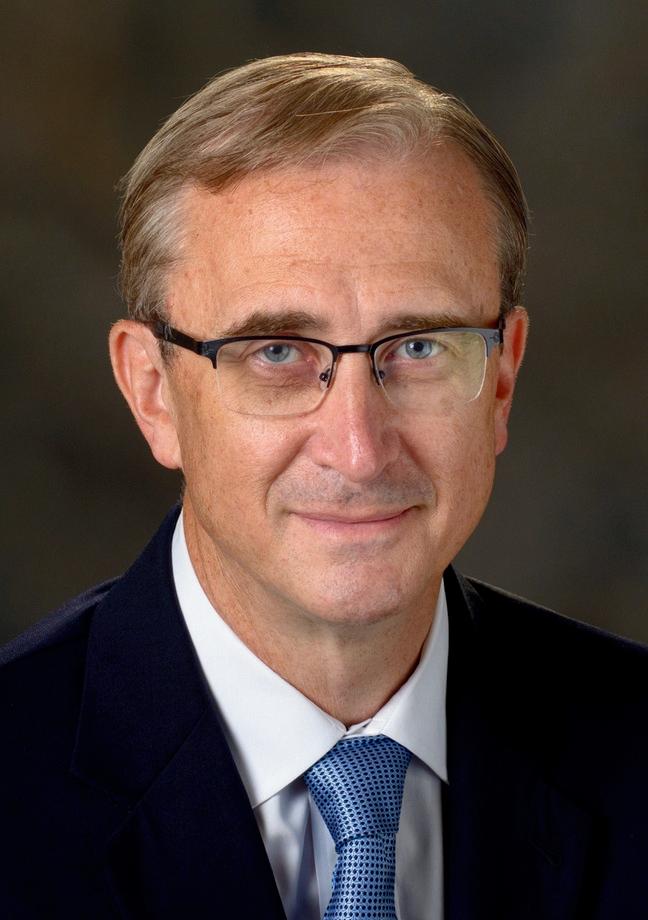
The Contrast Agent Molecular Engineering Lab (CAMEL), led by Dr. Marty Pagel, joined the Department of Medical PhysicsinMarch 2024. The CAMEL group focuses on molecular imaging of the tumormicroenvironment, including evaluations of tumor acidosis, hypoxia, enzymeactivity, andvascularperfusion.
To accomplish these imaging studies, the group uses CEST MRI, MR Fingerprinting, PET/MRI and photoacoustic imaging, while also involving chemical synthesis, cell biology, and advanced imageanalysis.
More recently, the CAMEL group has ventured into imaging vascular perfusion and hypoxia in wound healing models and has also developed innovative agents for optical surgical navigation. Pagel collaborates with Drs. Chetan Dhakan, Amali Subasinghe, Euitaek Yang, and David Murphy who are postdoctoral fellows in the CAMELgroup
“UW–Madison has an exceptional environment for clinical trials with MRI and PET/MRI. We look forward to expanding our resources to include clinicalphotoacousticimaginginstrumentation.”
In addition to research, Pagel will expand the department’s course offerings this fall teaching MP 671, Anatomy and Physiology for Medical Physics. In spring 2024 he will also begin managingthemedicalphysicsweeklyseminar.
Pagel is Co-Director of the Imaging and Radiation Sciences Program in the Carbone Cancer Center In addition, he serves as Editor-in-Chief of the journal Molecular Imaging and Biology, he coleads the PET-MRI study group for the ISMRM, and he organizes many scientific meetings and workshopsforourimagingresearchcommunity
Medical physics names next residency director

Alisa Walz-Flannigan
“A major reason for our transition from the MD Anderson Cancer Center to UW–Madison is the opportunity to expand our clinical imaging studies,” saysPagel 4
In June Dr. Alisa WalzFlannigan was named as the next Imaging Physics Residency Director, Department of Medical Physics and Radiology. Walz-Flannigan brings overadecadeof experience mentoring residents and teaching at the Mayo Clinic in Rochester, Minnesota In addition, she has spent five years leading a diagnostic physics and radiation safety division at Marshfield Clinic. Walz-Flannigan will lead the pathway forward in diagnostic imaging physics education and training, working closely with partnersinradiologyandmedicalphysicstorefine the department’s approach to daily clinical physics.
Walz-Flannigan will join the department in October 2024.
“Alisa has great insight into how to run clinical operations and how to mentor future medical physicists, " says Department Chair Brian Pogue “She has great intuition on how to connect with people and we look forward to her joining the teaminthefall.”

"It still feels like a distant dream to be able to contribute to the medical physics department at UW–Madison where I was once a student,” reflects Dr. Ahtesham Khan on his decisiontojointhe
departmentasanassistantprofessor.
“I am looking forward to bridging all the good memories I have of UW-Madison and future ambitions The unparalleled resources pulled me back for the next phase of my research and teaching career. I also have very fond memories of Madison including kayaking on the lakes and biking around which I am excited to get back into. I am looking forward to engaging with the UW community, especially the student body, and sharinginsightsthatwereonceimpartedtome
I am also excited to form new collaborations and work on the emerging problems in my field. FLASH radiotherapy and alpha-particle therapy are the two areas that I am currently most interested in Specifically, my work will aim to create novel dosimeters for FLASH radiotherapy that minimize dose rate dependencies and can be usedasreferenceorrelativedosimeters.
My research will also focus on standardizing dosimetry for alpha-particle therapies such as alphabrachytherapyandtargetedalphatherapy.
Both of these areas need immediate attention from radiation metrology researchers so that the full potential of these treatments can be realized.”

Congratulations to our medical physics graduates of both December 2023 and May 2024!
We celebrated with a hooding ceremony in May 2024 and several additional graduates will finish up their time here over the summer.


VictorFernandes(December)
Advisor: Dr. Jeraj
RuimingChen
Advisor: Dr. Wieben
EthanNikolau
Advisor: Dr. Speidel
JayseWeaver
Advisor: Dr. Dean III
AndrewWhite
Advisor: Dr. Culberson
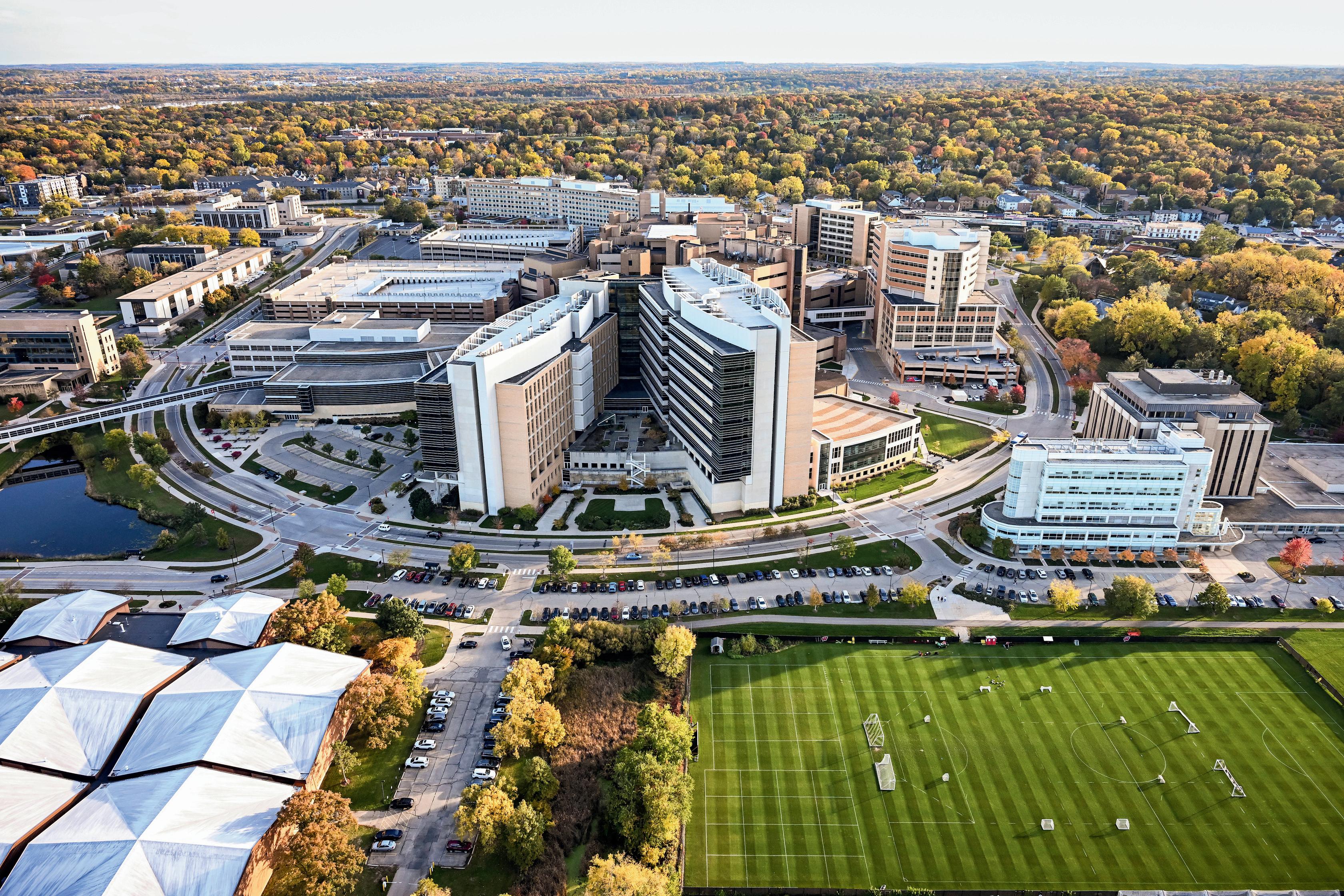
There's a lot to celebrate this year in the medical physics department! From 50 years of service to numerous accolades at conferences, our faculty/students have represented us well.
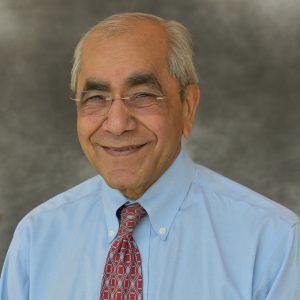
Bhudatt Paliwal, PhD celebrates 50 years of helping to advance lifesaving discoveries in cancer research and radiation therapy.
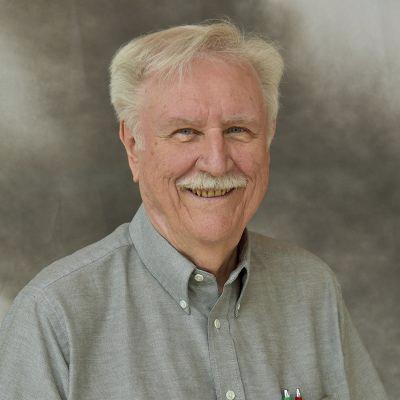

Beth Meyerand, PhD named Graduate School Associate Dean


Larry DeWerd, PhD
2024 American Brachytherapy Society Fellow
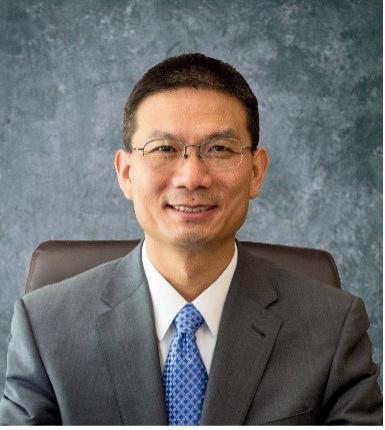
Kevin Eliceiri, PhD promoted to Professor, effective June 30. Named Retina Research Foundation
Walter H. Helmerich Research Chair
Guang-Hong Chen, PhD
2023 National Association of Inventors Fellow

Congratulations to the winners of our Student Research Symposium held on January 18, 2024.
1st Place - Aubrey Parks (middle)
2nd Place - Laura Castañeda Martínez (left)
3rd Place - Jeremy Hallett (right)
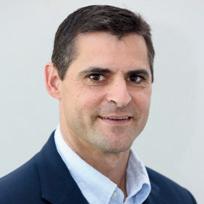
Brad Christian, PhD, was appointed Chair of the Radioactive Drug Research Committee (RDRC) at UW–Madison.
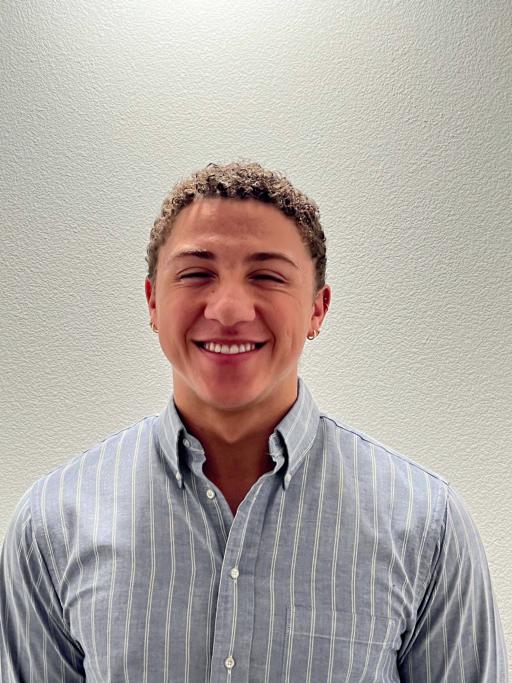
MJ Lindsey, National Science Foundation (NSF) Graduate Research Fellowship Program (GRFP) awardee

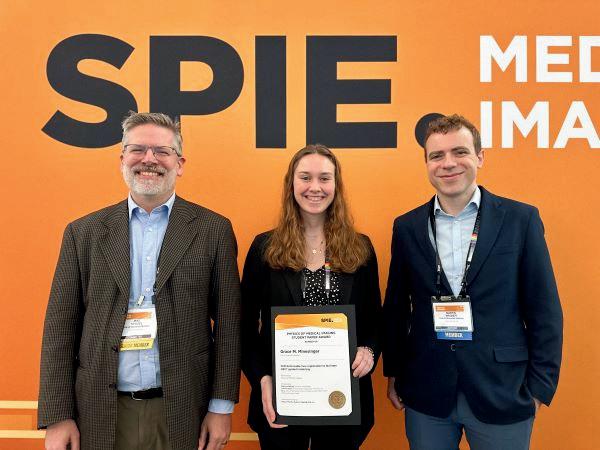
All-Conference Best Student Paper Award at the
SPIE Medical Imaging Conference


Recognizing research and teaching excellence, three faculty were recent recipients of awards for their contributions to the university.
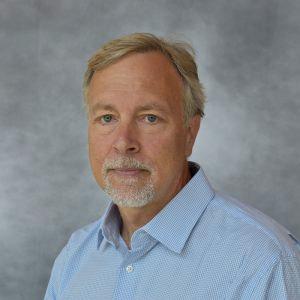
Andrew Alexander, PhD
Kellet Mid-Career Award
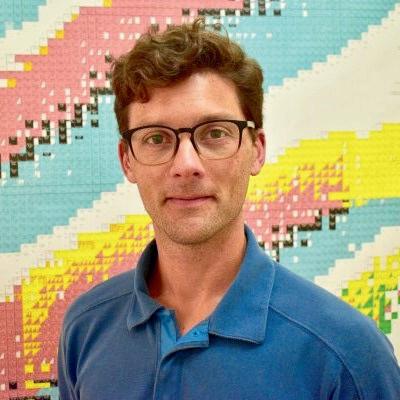
Jonathan Engle, PhD
Vilas Mid-Career Investigator Award

Ke Li, PhD
Vilas Associate

Last summer the medical physics department launched a program for undergraduates called ASSURE, Academic Summer Student Undergraduate Research Enhancement. This program aims to provide enrichment opportunities for promising undergraduate students pursing physics or related disciplines. Over the 10-week program, students work in medical physics labs, attend talks like how to apply or grad school and scientific communications, and participate in tours and social activities The summer session ends with a poster presentation
This summer the program expanded under leadership from graduate students Aubrey Parks (photo left) and Campbell Haasch It accepted nine ASSURE students with participants coming from both UWMadison and universities such as Notre Dame and Tulane
Parks is in her second year as a student liaison for the program. Parks says her commitment to the program stems from her positive experience as an undergraduate in an REU program in a cyclotron lab at Texas A&M.
“When the students first come in, they’re kind of nervous,” says Parks “It’s rewarding to watch them grow in their research over the summer and have an achievement by the time they’re finished.”


Dr Guang-Hong Chen | WARF Named Professorship (WARF)
Dr Guang-Hong Chen | Next Generation Cone Beam CT with Improved Contrast Resolution and Added Spectral Imaging Functionality (NIH)
Dr. Bradley Christian | Novel Tau-Targeted Radiohalogenated Agents for Alzheimer' s Disease (NIH)
Dr. Larry DeWerd | Dosimetry and Protocols for Radiation Biology Users (Battelle Memorial Institute)
Dr. Kevin Eliceiri | Micro-Manager CZI Imaging Software Fellow (Silicon Valley Community Foundation)
Dr Kevin Eliceiri | Romnes Faculty Fellowship (WARF)
Dr Paul Ellison | Modernizing radiobromine: improved radiohalogenation methodologies for translating 76/77Br theranostics (SNMMI)
Dr. Marina Emborg-Knott | Frontotemporal Dementia in Rhesus Macaques (NIH)
Dr. Jonathan Engle | University of Wisconsin Cyclotron Group Contribution to the Isotope Program University Isotope Network (DOE)
Dr. Jonathan Engle | The fate of Bismuth daughter radionuclides in targeted alpha therapy (WARF)
Dr Jonathan Engle | Stem Cell-derived Islet Vascularized Extracellular Matrix Organoids for Enhanced Transplantation Success (Juvenile Diabetes Research Foundation)
Dr. Jonathan Engle | VILAS Faculty Mid-Career Investigator Award (William F. Vilas Trust)
Dr. Reinier Hernandez | Development of CA9targeted radiopharmaceutical agents for kidney cancer theranostics (DOD)
Dr. Kevin Johnson | VILAS Associate ProfessorBiological Sciences Award (William F Vilas Trust)
Dr. Brian Pogue | Oxygen dynamics in FLASH Radiotherapy (NIH)
Dr. Brian Pogue | Cherenkov Excited Luminescence Metabolic Sensing (CELMS) (NIH)
Dr Michael Speidel | Clinical and theoretical evaluation of qDSA (Siemens Medical Solutions, Inc.)
Dr. Michael Speidel | Advanced imaging methods for embolization procedures (Siemens Medical Solutions, Inc.)
Dr. Ronald Wakai | 2024-2025 Fall Competition Award (WARF)

By Sarah Benzel, UW Health Communications
The University of Wisconsin Carbone Cancer Center is now home to the Initiative for TheranosticsandParticleTherapy
This initiative will foster collaboration between experts across medical oncology, radiation oncology, radiology, nuclear medicine, medical physics and other specialties to accelerate precision radiation therapy and imaging for patients treated through the UW Health | CarboneCancerCenter.
The University of Wisconsin–Madison is the perfect setting for this initiative, according to Dr. Zachary Morris, co-director of the initiative, radiation oncologist at UW Carbone and associate professor of human oncology at the University of Wisconsin School of Medicine and Public Health. “We have a unique combination of unparalleled strengths here at UW,” he said
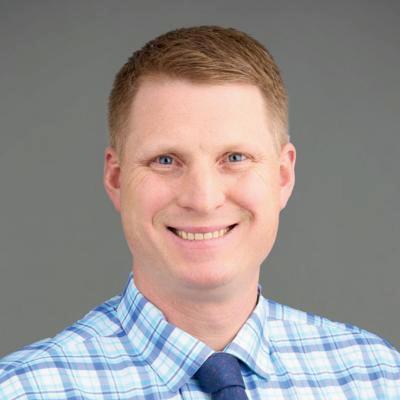
A key focus of the initiative will be translational research, or research that is designed Zachary Morris
to benefit human health Investigators will assess how particle beam radiation may be effective to treat cancers that are difficult to treat using conventional radiation therapy, how diagnostic and treatment steps can be combined into a
single step referred to as theranostics, and how radiation treatment plans can be personalized for each patient.
Depending on location of a tumor or other considerations, traditional radiation methods could expose neighboring healthy tissue to radiation doses that would exceed safe limits Limiting radiation exposure for children with cancer can also be a goal. In such instances, particle beam radiation may be a preferred treatment.
Some researchers and clinicians with the Initiative for Theranostics and Particle Therapy will focus on particle beam radiation used in, for example, proton therapy, in which radiation travels to a specified depth in the tissue and stops, reducing the delivery of potentially harmful radiation to healthy tissues and sparing patients from some treatment-related toxicities.
Proton therapy will be offered to patients at the UW Health Eastpark Medical Center.
Targeting tumors typically requires using medical imaging to locate the precise position of a tumor during treatment.
Iftherearemanytumorstotargetthroughoutthe body inparticular, smallandmicroscopictumors thiscanbeimpossible.
To address this challenge, researchers with the initiative will also focus on radiopharmaceutical therapy, also known as targeted radionuclide therapy, or TRT. This type of therapy involves injecting an agent that selectively delivers radiation to tumors no matter their size or location These agents have been shown to prolongsurvivalformanypatients, includingthose with certain forms of thyroid, prostate and neuroendocrine cancers as well as pediatric neuroblastoma.
“Investigators at UW are pioneering the development of novel TRT agents and testing these in combination with other cancer treatments like immunotherapies with the goal of curing cancer in patients previously believed to haveincurabledisease,” Morrissaid
Depending on the form of radioactivity attached to the radiopharmaceutical, the same TRT agent can be used not only for cancer therapy but also as a new way to detect and image cancers using advanced technologies such as positron emission tomography, or PET The combination of PET molecular imaging and TRT provides a powerful tool for both diagnosis and treatment. These agents are called “theranostics” due to this dual therapyanddiagnosticrole, accordingtoDr. John Floberg, assistant professor of human oncology, UW School of Medicine and Public Health, and radiationoncologist, UWHealth.
“Researchers with the initiative will be doing critically important work to advance the translation of theranostics and particle therapy into curative treatments for patients with metastaticcancers,” hesaid.
Dosimetry: Personalizing the right dose for individual treatment plans
Theranostic imaging allows doctors to measure precisely how impactful a TRT is for an individual patient’s cancer cells. By leveraging that capability, researchers at UW–Madison have also developed technologies that allow doctors to use theranostic images to personalize the prescription of a TRT to be maximallyeffectiveandsafeforeachpatient.
The process of identifying patient-specific amounts of a radiopharmaceutical therapy drug is called dosimetry, according to Bryan Bednarz, professor of medical physics at UW–Madison.
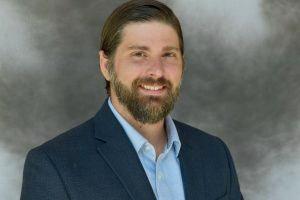
Dosimetry allows doctors to calibrate in a way that is more fine-tuned than if they rely solely on standard dosage guidelines, so they can create a personalized dosage plan for each individual that maximizes effectiveness while minimizing harm, he said
“This combination of advancements is a critical component of the future for cancer diagnosis and therapy,” Bednarz said.
Creating synergy between areas of expertise Morris describes the initiative as uniquely cooperative.
“The initiative provides a central mechanism for those involved in these fields to engage with one another and put ideas together for collective advancement,” he said “This area is inherently multidisciplinary. If we stay in our silos, we only get so far, but when we work together, we can see the confluence of opportunities.”
Initiative researchers aim to develop novel cancer-targeted molecular imaging and radiotherapy TRT agents, produce more effective theranosticimagingandparticletherapy, advance dosimetry methods and translate discoveries to clinicalpractice
The initiative will also establish premier graduate and fellowship training programs for researchers and practitioners in theranostics, particle therapy, dosimetry and nuclear and radiochemistry, according to Jamey Weichert, professor of radiology, UW School of Medicine and Public Health, andco-directoroftheinitiative.

“We’re creating a destination theranostics and particle therapy clinical center at UW Health | Carbone Cancer Center with this work,” he said.
For researchers and clinicians at UW who work in these areas and wish to become involved, the initiative will establish membership criteria, and theunitwillbegovernedbyanexecutiveboardof six UW–Madison faculty members who engage in research, clinical care and education related to theranosticsandparticletherapy.
This work is possible thanks to major federal funding provided to UW–Madison, including the first National Institutes of Health-supported program project grant for theranostics, according to Anjon Audhya, senior associate dean for basic research, biotechnology, and graduate studies at theUWSchoolofMedicineandPublicHealth
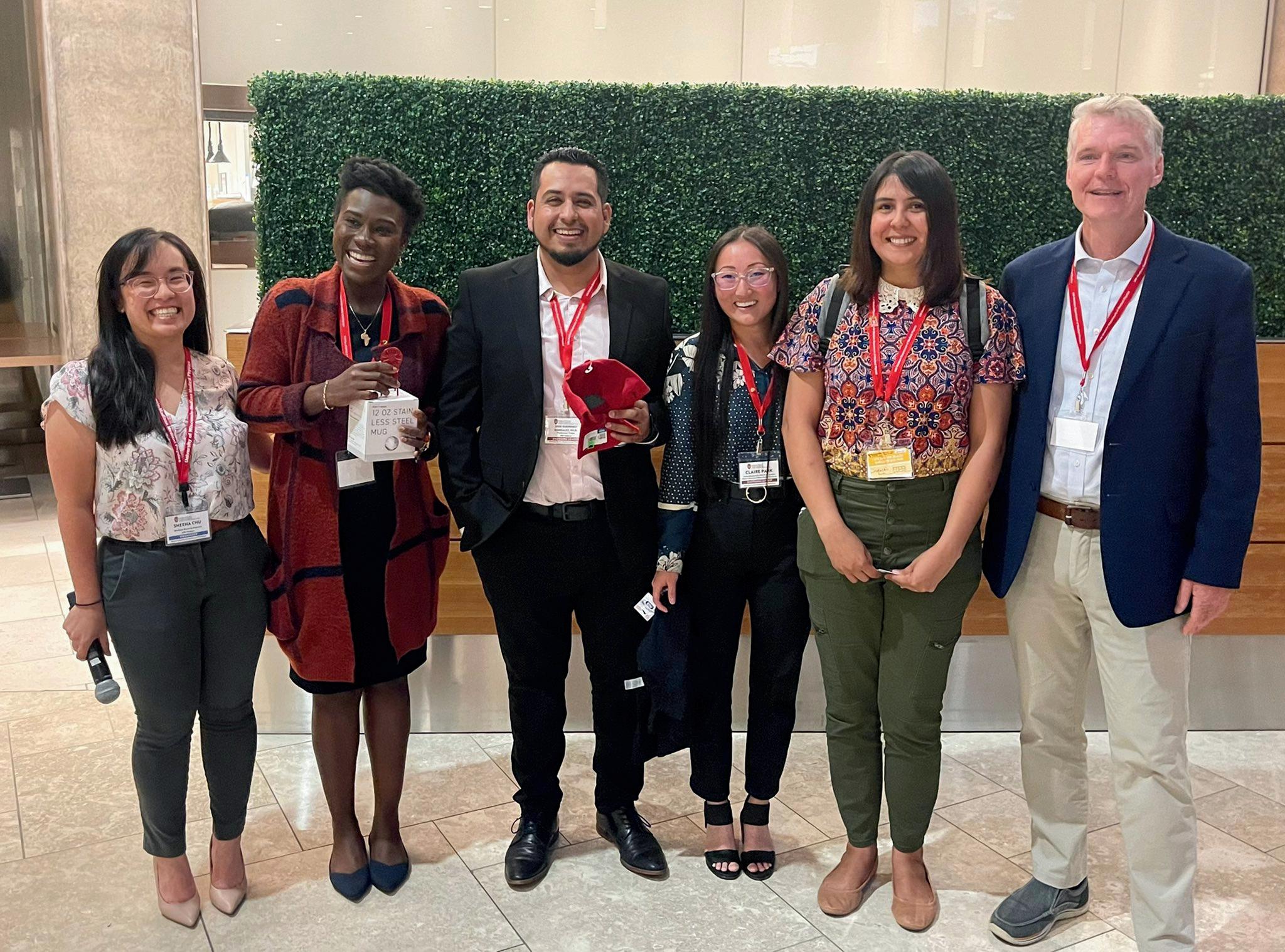
hosting its second Emerging Leaders of Academic Medical Physics Symposium & Workshops on August 21-23.
This event brings scholarly-focused, early-career, diverse scientists together with visionary leaders and mentors, who are interested in shaping the future of academic medical physics. It includes a public science symposium of presentations and discussion panels, followed by task-specific workshops to support early career participants for mentoring and networking sessions, themed around the future of the field
Sixteen Emerging Leaders were selected from all over the world - from Chicago to Canada, Europe, and Australia.

connecting with invited speakers, faculty and Board of Visitors. This year’s speakers include:
Carolyn Anderson, PhD, Director, MIZZOU Molecular Imaging & Theranostics Center
Sha Chang, PhD, Professor, Radiation Oncology, University of North Carolina, Founder, EmpowerRT, LLC
Georges El Fakhri, PhD, Director, Yale PET Research Center, Yale School of Medicine
Thomas Foo, PhD, Chief Scientist, Biology & Applied Physics, GE Global Research
Ron Kikinis, MD, Professor, Radiology, Harvard Medical School
Beth Meyerand, PhD, Vice Provost for Faculty & Staff Affairs, University of Wisconsin
Julianne Pollard-Larkin, PhD, Physics Section Chief of Thoracic Service, MD Anderson Cancer Center
Charles Thomas, MD, Chair, Radiation Oncology, Dartmouth Health
PaulM. DeLucaJr., emeritusprofessorofmedical physics and former provost of the University of Wisconsin–Madison, diedonOct. 30. Hewas 79. DeLuca arrived at UW–Madison in 1971, and acrossmorethanfourdecades, heservedaschair of the Department of Medical Physics as well as vice dean for research and graduate studies for the School of Medicine and Public Health. He served as provost and vice chancellor for academic affairs from 2009 until his retirement in 2014, working with chancellors Biddy Martin, DavidWardandRebeccaBlank.
After completing his doctorate in nuclear physics at the University of Notre Dame, DeLuca worked at UW–Madison as a postdoctoral fellow and assistant scientist before he joined the faculty in 1975. Over the years, his role in the school and across campus continued to expand. He spent 10 years as departmental chair, followed by broader administrativeroles.
DeLuca was born in 1944 in Troy, New York The son of a neurosurgeon, he knew from a young age that he wanted to pursue a career in medicine but said he wanted to “come at it from another direction.” He focused on the connection betweenphysicsandmedicine
“Every time I did a physics experiment, it was a different experiment,” he said. “No one could predict the results. Everything was a surprise, and Ireallyenjoyedthat.”
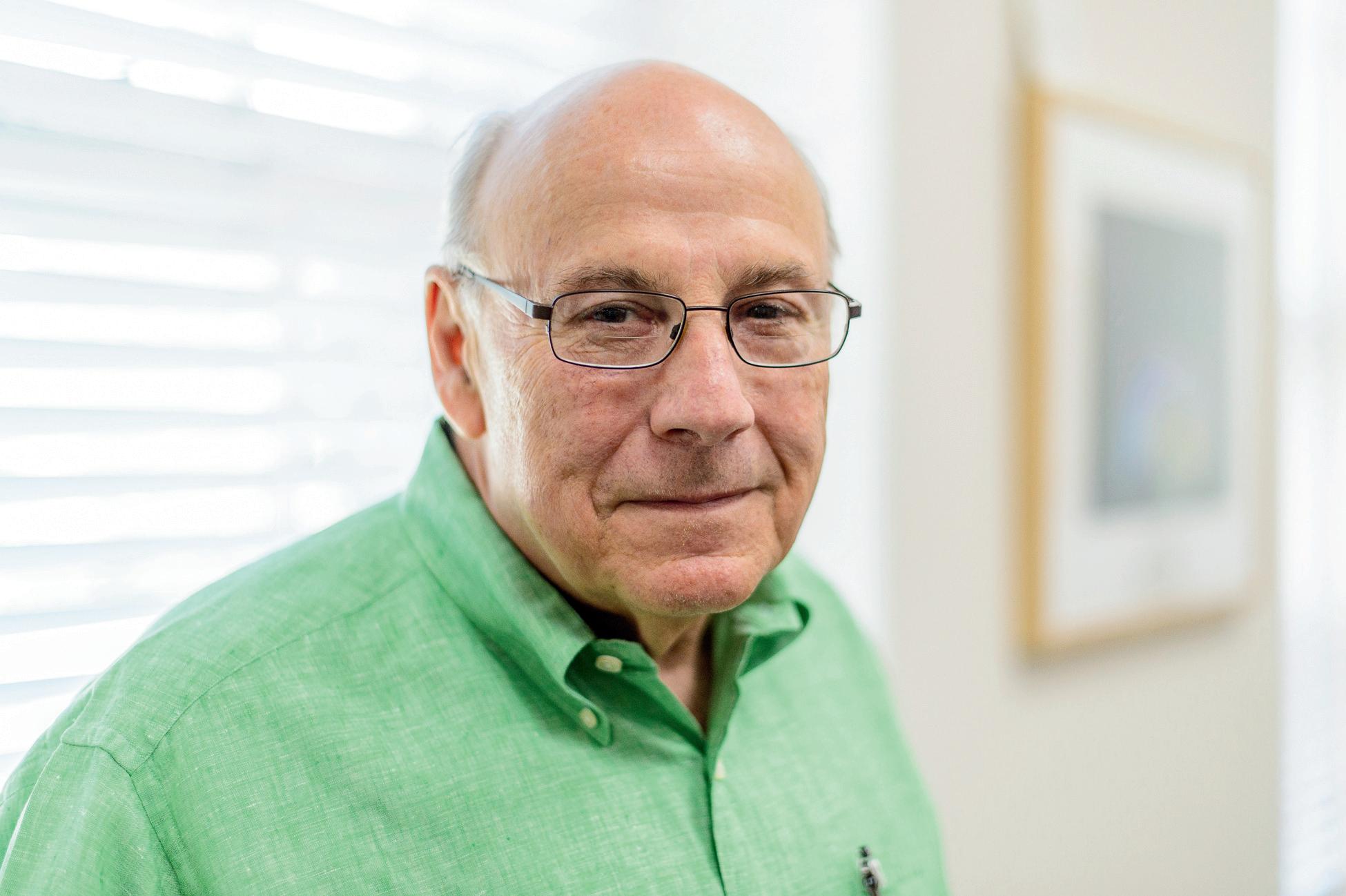
“As an administrator and champion of the school and UW–Madison’s research enterprise, DeLuca helped shape the university’s future. He helped greatly expand the research, training programs and facilities of the Department of Medical Physics during his time as chair. As vice dean for the School of Medicine and Public Health he was instrumental in the development of the Wisconsin Institutes for Medical Research and other researchinitiatives.
Paul was a spectacular leader, colleague and friend He served as the school’s vice dean for research and graduate education with incredible wisdom, effectiveness, warmth and great humor,” says Robert N. Golden, dean of the school. “I was delighted when he became provost and deeply valued the opportunity to work with him in advancing the vision and missions of our university.”
As provost, DeLuca guided major leadership changes at the university, playing a lead role in the recruitment and hiring of 10 new deans and directors for various schools, colleges and institutes. He helped develop programs to advance the quality of undergraduate education, launch innovative massive open online courses and initiate and advance Discovery to Product, or D2P, a major partnership between UW–Madison and the Wisconsin Alumni Research Foundation that focuses on entrepreneurship and technology transfer
Withhiswide-ranginginterests, heclearlyenjoyed the role of provost, where he had the opportunity to work with the entire campus,” says Eden Inoway-Ronnie, chief of staff to the provost and who worked with DeLuca while he served in that role “He was passionate about many things, and I know he cared deeply about the education and research opportunities we provide here at UW–Madison.”
As a researcher, DeLuca focused throughout his career on the connection between physics and medicine. He is known for his studies on the effects of high-energy particle radiation on humans. He authored and co-authored more than 75 research papers, many focusing on the various applications of physics to the diagnosis and treatment of cancer As a teacher, he supervised nearly 50 graduate students and postdoctoral fellows.
He received the William D. Coolidge award from the American Association of Physicists in Medicine in 2016 and the UW Medical School Folkert O. Belzer Lifetime Achievement Award in 2005. He was a Fellow of AAPM and in 2007 was named UW–Madison Rennebohm Research Professor.
Prior to retiring from the university in 2014, DeLuca reflected on his work bringing physicians andscientiststogether.
“Well, I think that [my work] brought the medical school constituents into a true intellectual pair,” he said “In other words, it was not a few scientists hanging around a bunch of clinicians seeing patients. It became a team of physicians and scientists working together to advance health care. AndIthinkIhadafairbittodowiththat.”

Join
us for an afternoon celebrating the life and contributions of Dr. Paul M. DeLuca Jr
.
Wednesday, August 21 3-5 p.m.
Reception to follow Pyle Center, Alumni Room
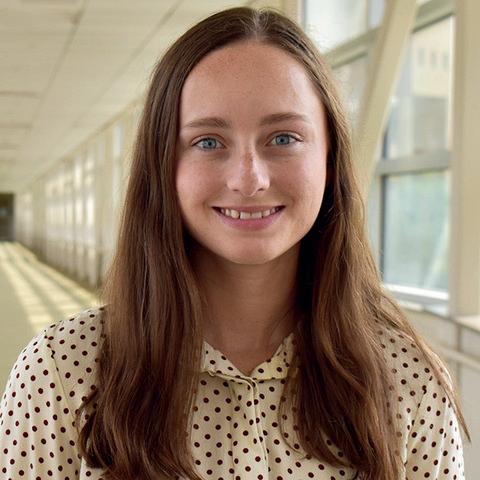
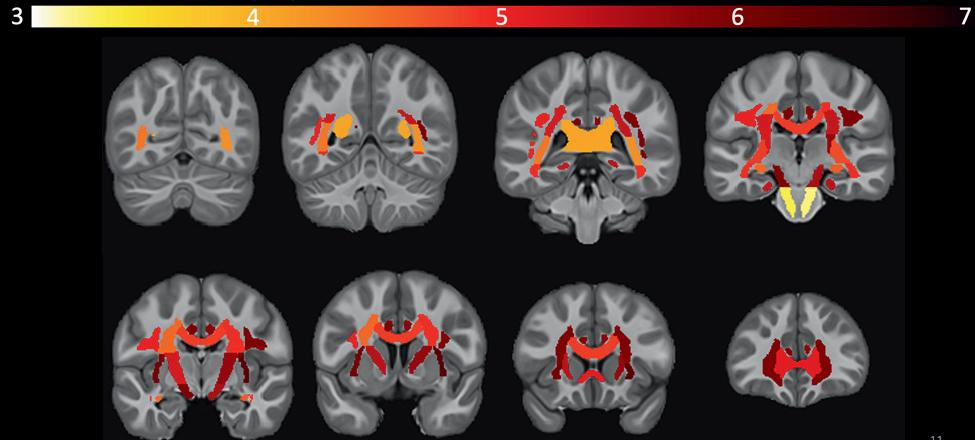
Graduate student Carly Allen (top left) was the inaugural recipient of our Paul DeLuca PhD, Scholar Fund recognizing graduate students with exceptional potential in the field of medical physics. Carly joined the medical physics department in 2023 after completing undergraduate studies at the University of Chicagowithadegreeinphysics
Carly is investigating with Professor Andy Alexander how the rate of brain development compares in non-human primates and humans She is trying to find a more quantitative way to see how much more quickly non-human primate infant brains are maturing compared to human infants.
It is believed that, non-human primates’ brains develop 3 to 4 times faster than humans, but this is not based on brain imaging. Carly is comparing the myelination rates, a marker of brain development, usingdatatakenfromMRIscansto find a ratio between non-human primate brain developmentversushumanbraindevelopment
She has found that non-human primates' brains develop five times faster than humans, but this maturationratiorangesfrom 3-6 timesfaster

depending on what part of the brain is being analyzed
This brain maturation ratio can be used in planning future research studies that use nonhuman primates as a model for human brain development It will also help provide a way to correspond the developmental timepoints in the non-human primates to the developmental timepoints of interest in humans. She recently presented on this work at the International SocietyofMagneticResonanceImaging (ISMRM) internationallyinSingapore

Carly’s other projects include pulse sequence development She is currently learning to program the MRI scanner to create new techniques to acquire data more efficiently and make the scans quieter and more robust if a patient were to move duringalongscan.
In her free time Carly enjoys playing tennis, tending to her house plants, gardening, crocheting, andhiking.
Cover photo: A color map of the ratios of maturation time constants of non-human primates and humans. The variation in color shows the regional dependence of the maturation ratios, meaning that certain brain regions in the rhesus macaques are developing at a faster rate compared to humans.
You’reinvitedtoourAlumni & FriendsreceptionMonday, July 22 from 8:30-11 p.m.
JoinusforappetizersandbeveragesattheMarriottCourtyard, 901 W OlympicBlvd
New this year! We’re hosting a booth at AAPM in the graduate & residency program area. Comeseeusatbooth #1543!



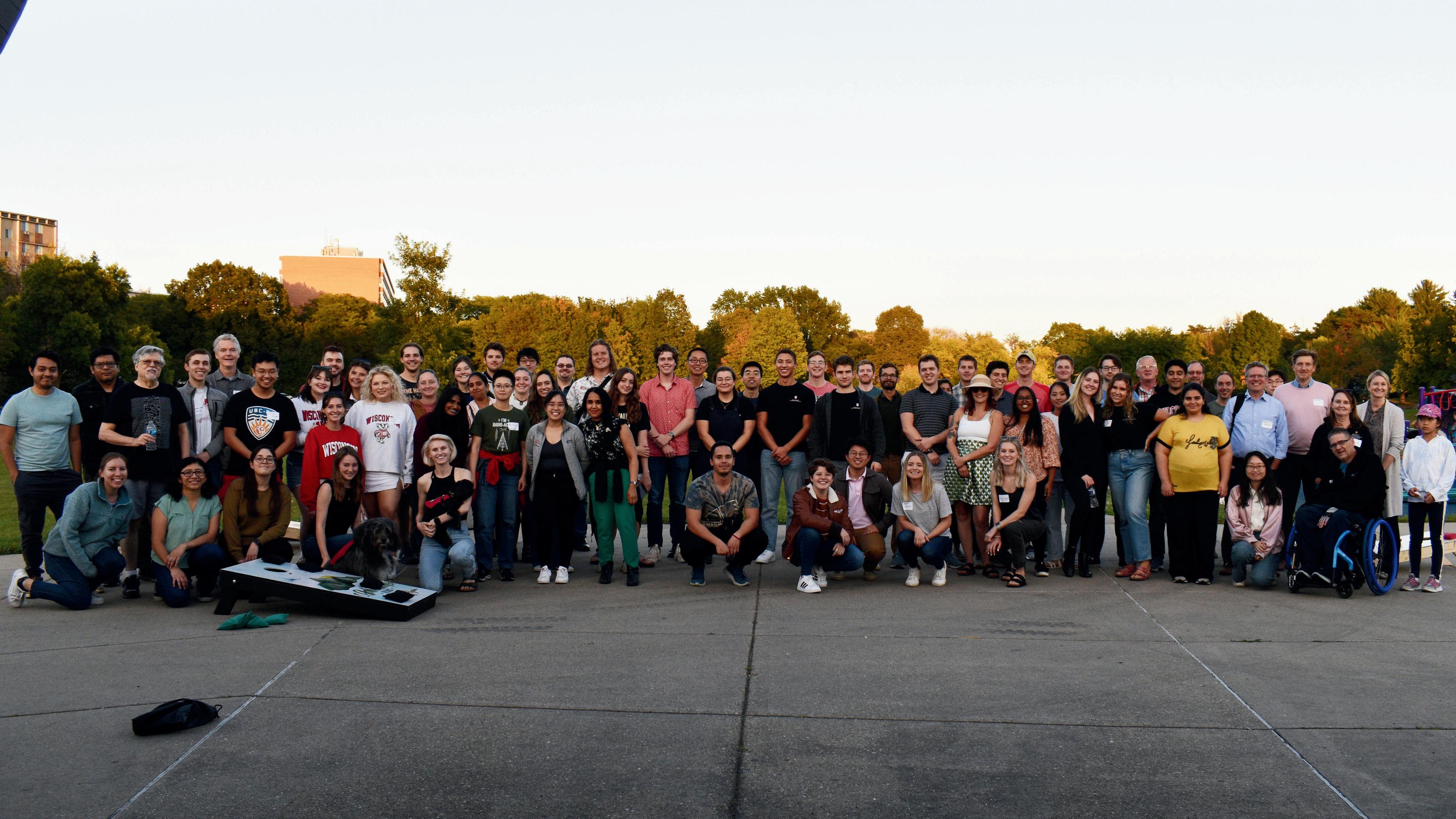
When you give to the University of Wisconsin Medical Physics Department through the UW Foundation, you're providing the resources to purchase modern equipment, initiate new research programs and support our students well into the future. Thank you!
The fund provides discretionary funding to the Department of Medical Physics Chair and is dedicated to provide financial assistance for the department’s missions of teaching, research, and service. Examples of how such funds may be used include, but is not limited to, travel awards, research, and equipment.
This fund is specifically dedicated to support the establishment and ongoing development of medical physics lectures and regularly held seminars. Examples of how such funds may be used include, but are not limited to, travel and honoraria for lecture speakers.
This fund is specifically dedicated to provide funds for a fellow in medical physics. The fellowship will provide supplemental funding for a post-graduate fellow in medical physics, thereby, allowing that fellow the opportunity to pursue areas of research and teaching in the field.
This fund will support the broad educational and professional development of medical physics select graduate students giving them the freedom to pursue innovative projects wherever they may lead. This fund was formed in 2021 in honor of Emeritus Professor, Paul DeLuca.

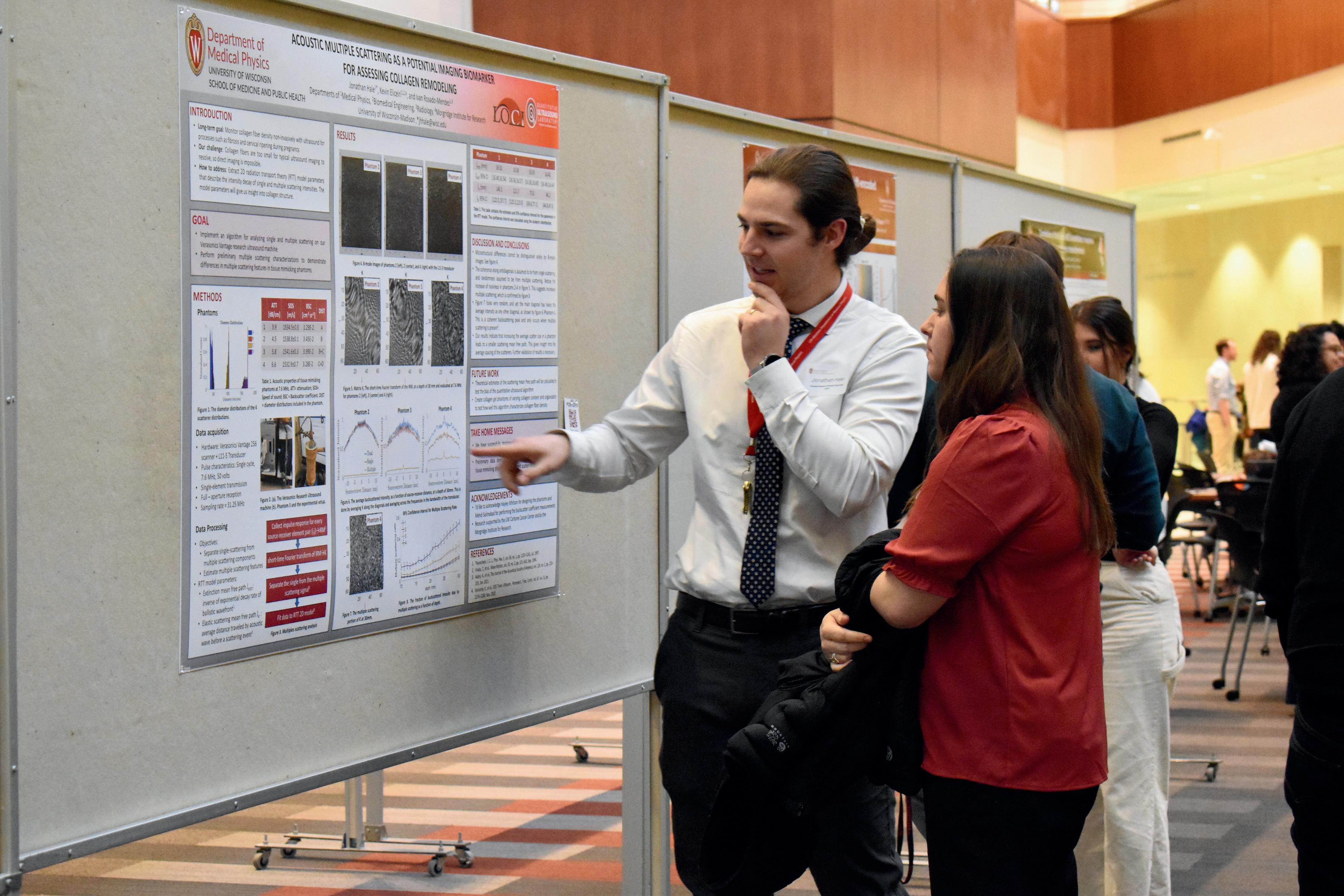
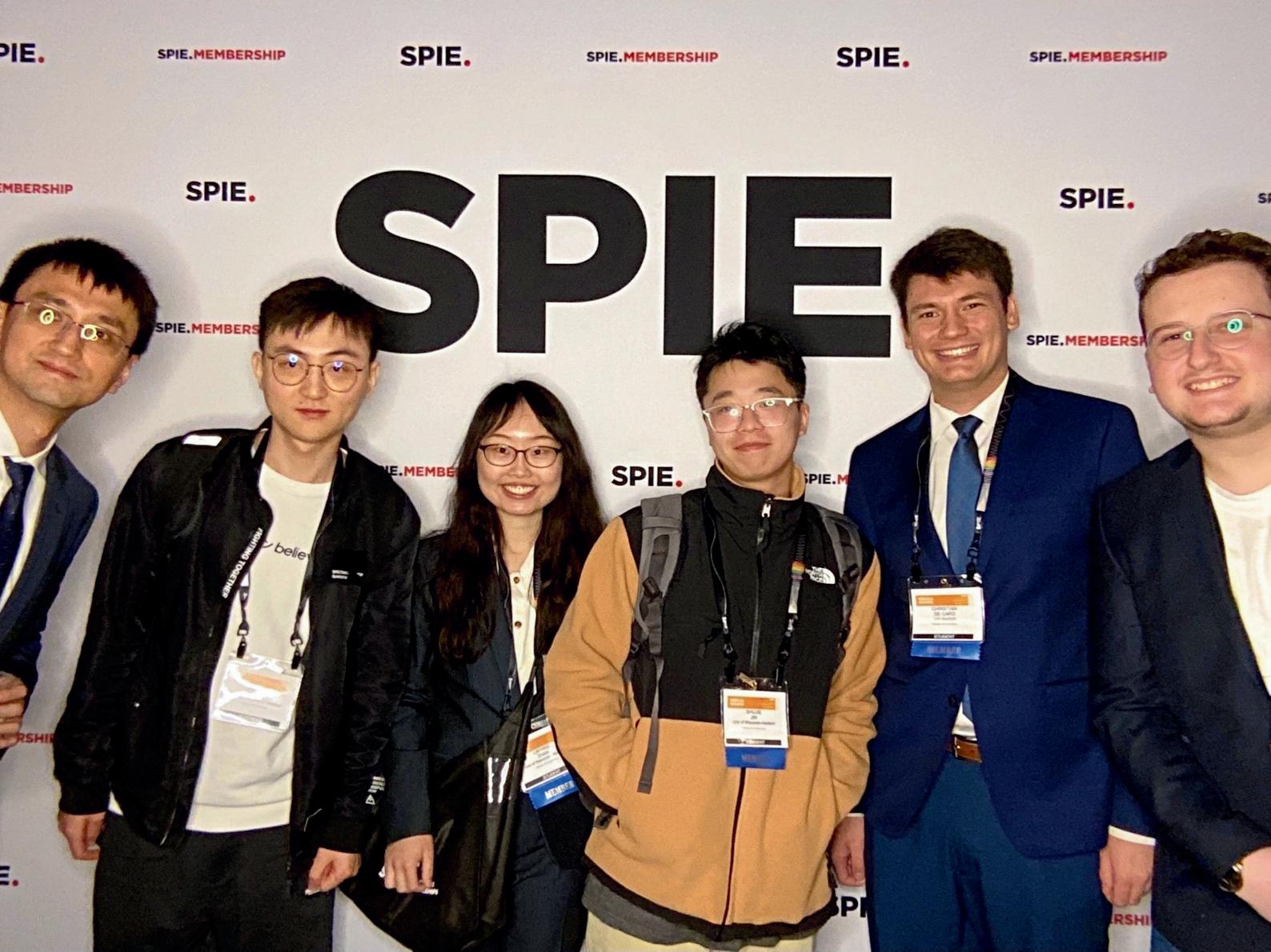
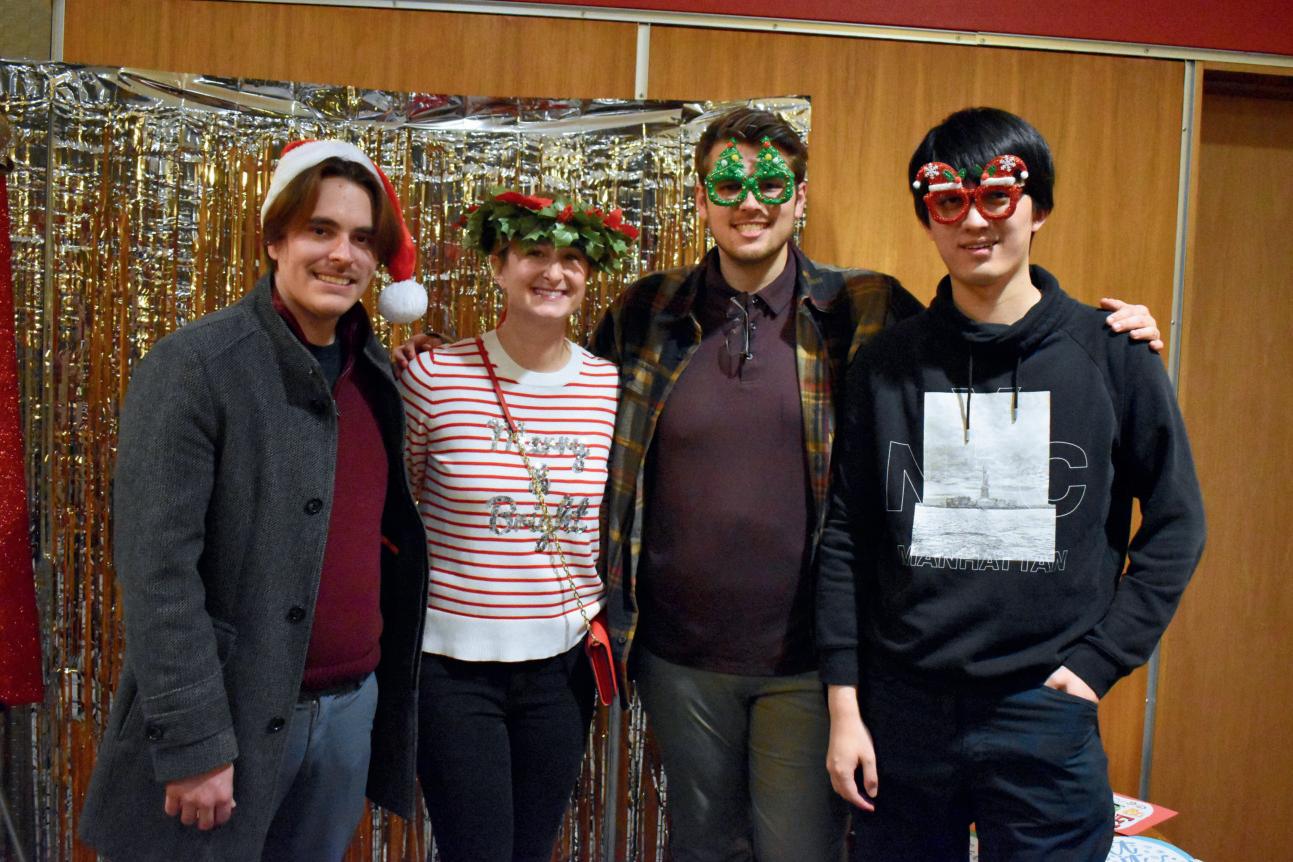
Thank you for your support!
